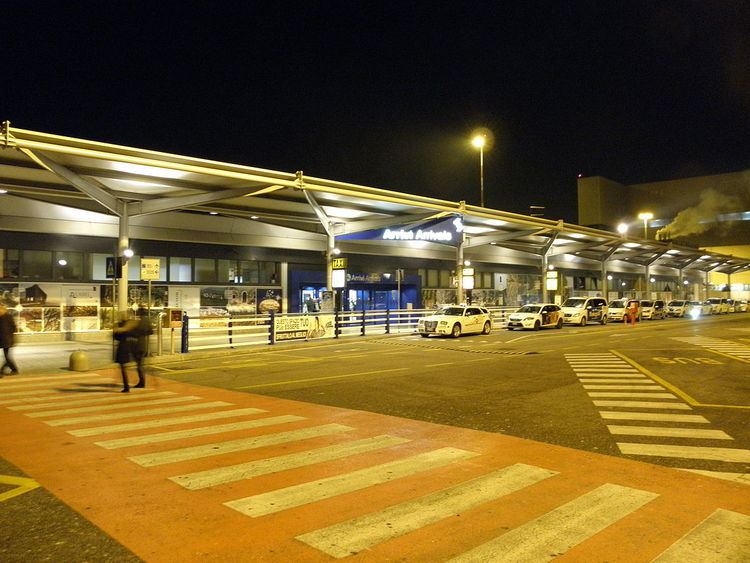Airport type Civil / Military Focus city for MeridianaNeosVolotea Code VRN Yearly aircraft movements 28,700 | Operator GardaAeroporti Elevation AMSL 240 ft / 73 m Elevation 73 m Phone +39 045 809 5666 Passenger count 2,807,811 | |
 | ||
Address 37066 Caselle Province of Verona, Italy Profiles | ||
B735 takeoff at verona villafranca airport
Verona Villafranca Airport (IATA: VRN, ICAO: LIPX), also known as Valerio Catullo Airport or Villafranca Airport, is located 10 km (6.2 mi) southwest of Verona, Italy. The airport is situated next to the junction of A4 Milan-Venice and A22 Modena-Brenner motorways. It serves a population of more than 4 million inhabitants in the provinces of Verona, Brescia, Mantua (Mantova) and Trentino-Alto Adige/Südtirol.
Contents
- B735 takeoff at verona villafranca airport
- Early years
- Expansion in 1990s and 2000s
- Current Development 2010s
- Facilities
- Ground transportation
- References
Early years
Villafranca Air Base was a military airport during the First World War. It became open to civil traffic in the early 1910s with daily scheduled connections to Rome and charter flights to destinations in northern Europe.
Towards late 1970s, under the first community project by the Province of Verona, Comune of Verona and the local Chamber of Commerce, Villafranca Airport constructed a passenger terminal, offices and handling facilities. The managing society, "Aeroporto Valerio Catullo di Verona Villafranca S.P.A.", was established in December 1978. Ownership is currently shared between provincial governments from Veneto (Villafranca di Verona and Sommacampagna), Lombardy (Province of Brescia), Trentino (second main shareholder) and Alto Adige/Südtirol.
Expansion in 1990s and 2000s
In 1990, the passenger terminal was expanded in order to cope with the constantly growing air traffic. The aircraft apron and car-parking areas were enlarged; in addition, access to the airport was improved by a road link to Verona's new ring road (SS12) on the occasion of World Cup 1990).
In 1995, the airport has reached a record of handling one million passengers per annum. In 1999, the airport became Italy's second-grade airport in the 'Special Classification of Charter Traffic' and ranked after Milan Malpensa Airport and Rome Fiumicino Airport.
Passenger numbers continued to grow: 2 million per year in 2001 and 3 million per year in 2006. In response to the strong demand in patronage, the airport has undertaken a significant expansion programme on its services and facilities. In May 2006, a new arrivals terminal, Terminal 2, was opened by the Vice-Minister of Transport, Cesare De Piccoli, and Vice-President of Veneto Region, Luca Zaia. This additional terminal is situated immediately next to the original building, now known as Terminal 1. As a result of the expansion programme, the airport's capacity has doubled. Hence Terminal 1 is used solely for departures and Terminal 2 for arrivals.
Current Development: 2010s
Air traffic has continued to grow during the 2010s with 3,385,794 passengers recorded in 2011. After a European Union investigation into high subsidies being granted to Ryanair on their scheduled routes, the airliner pulled out of Villafranca Airport in 2012. This caused a reduction in passeneger traffic in 2013.
In 2015, Ryanair has reintroduced services to the airport with scheduled flights to Palermo, London Stansted and Brussels. Several airlines have switched their charter routes to regular services during the Winter Season 2015-16: Finnair flies between Verona and Helsinki and AirBaltic flies between Verona and Riga. The route between Paris and Verona, as operated by Air France, however, ceased operation in late October 2015, having been replaced with flights operated by its low-cost subsidiary, Transavia.
Facilities
Verona-Villafranca Airport is equipped with a fog-dispersal device, which remains the best solution available in Italy and abroad to date, so that flight operations could continue during times of low visibility. This system has been in operation since 2003 and allows pilots to land in visibility as low as 75 m (246 ft). The runway is certified for ILS Category IIIb approach.
The two terminals, departures and arrivals, are situated next to each other. The departures hall hosts check-in facilities at the eastern side. The lounge is located on the first floor's eastern wing. The main bus stand is located directly outside the arrivals hall.
Ground transportation
A shuttle bus service, Aerobus (199) operated by ATV, connects Verona-Villafranca Airport directly with Verona Porta Nuova station. This Aerobus runs daily between 6 am and 11 pm and departs every 20 minutes. Journey time takes 20–25 minutes. [1] [2]
During the summer months (June to September), ATV (Verona) buses 164, 183 and 184 additionally provide hourly connections between Verona-Villafranca Airport en route to comunes along Lake Garda/Lago di Garda.
From March 2013 to December 2014, a direct shuttle bus service ran daily between Mantova railway station and Verona-Villafranca Airport, connecting the city with its closest international gateway. This service was provided by APAM. The journey took 45 minutes. This service ceased operation on 1 January 2015. [3]
